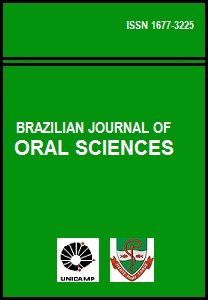Abstract
Taste allows to human beings to detect and to distinguish food, setting a nutritive diet by means of the gustatory signs that balance the quantity and the quality of meals. The physiology of taste has been studied since intrauterine life, concerning its important role in the future dietary pattern of the child. As food intake is directly related to oral health, it is recommended that dentists know and help parents to select their own and their children dietary pattern. The present article reviews research about the physiology of taste and the process of food acceptance by infants according to their metabolic needs, with the aim of giving health professionals a set of additional information on this subject.References
Yamaguchi S, Ninomiya K. Umami and food palatability. J Nutr 2000; 130: 921-6.
Birch LL. Development of food acceptance patters in the first years of life. Proc Nutr Soc 1998; 57: 617-24.
Schiffman SS. Fisiologia do paladar. Anais Nestlé 1999; 57.
Lecanuet J, Shaal B. Fetal sensory competencies. Eur J Obstetrics Gynecol 1996; 68: 1-23.
Drewnowski A. Taste preferences and food intake. Annu Rev Nutr 1997; 17: 237-53.
Beauchamp GK, Mennella JA. Períodos sensíveis no desenvolvimento da percepção dos sabores e na sua escolha pelo ser humano. Anais Nestlé 1999; 57.
Rosenstein D, Oster H. Differential facial responses to four basic tastes in newborns. Child Dev 1990; 59: 1555-68.
Hudson R, Distel H. The flavor of life: perinatal development of odor and taste preferences. Schweiz Med Wochenschr 1999; 129: 176-81.
Cambraia RB et al. Effects of malnutrition during early lactation on development and feeding behavior under the self-selection paradigm. Nutr 2001; 17: 455-61.
Goto T, Komai M, Suzuki H, Furukawa Y. Long-term zinc deficiency decreases taste sensitivity in rats. J Nutr 2001; 131: 305-10.
Krebs NF. Dietary zinc and iron sources, physical growth and cognitive development of breastfed infants. J Nutr 2000; 130: 358-60.
Mennella JA, Beauchamp, GK. Flavor experiences during formula feeding are related to preferences during childhood. Early Hum Dev 2002; 68: 71-82.
Hammer LD. The development of eating behavior in childhood. Pediatr Clin. North Am 1992; 39: 379-94.
Birch LL. Development of food preferences. Annu. Rev Nutr 1999; 19: 41-62.
CERRO N et al. eating behaviour of children 1.5-3.5 years born preterm: parent’s perceptions. J. Paediatr. Child Health 2002; 38: 72-78.
Eertmans A, Baeyens F, Van Den Berg O. Food likes and their relative importance in human eating behavior: review and preliminary suggestions for health promotion. Health Educ Res 2001; 16: 443-56.
Pliner P. Development of measures of food neophobia in children. Appetite 1994; 23: 147-63.
Blundell JE, Lawton CL, Hill AJ. Mechanisms of appetite control and their abnormalities in obese patients. Horm Res 1993; 39: 72-6.
Young B, Drewett R. Eating behaviour and its variability in 1- year-old children. Appetite 2000; 35: 171-7.
Wyrwicka W. Social effects on development of food preferences. Acta Neurobiol Exp 1993; 53: 485-93.
The Brazilian Journal of Oral Sciences uses the Creative Commons license (CC), thus preserving the integrity of the articles in an open access environment.

